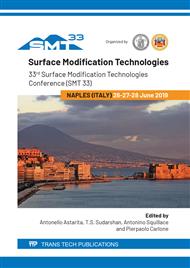p.178
p.185
p.191
p.197
p.203
p.209
p.215
p.221
p.228
Study of the FDM Parameters of the ABS Parts in the Surface Quality after Machining Operations
Abstract:
Additive Manufacturing (AM) is one of the Key Enabling Technologies (KET’s) in Industry 4.0. One of the most worldwide used technologies is Fussed Deposition Modelling (FDM), a technology commonly used for domestic purposes. However, it could become a profitable option for industrial applications such as protections parts, flexible clamping systems or large volume parts. One of the issues that keeps this technology away from the mainstream industry is the lack of dimensional accuracy and the appearance of layer deposition defects that are produced as a consequence of the nature of the process. Those defects are usually reduced using chemicals post treatments. However, this option considerably increases the cost of the part as well as it environmental impact for big size parts. This work studied machining procedures as sustainable post-operation in order to reduce FDM dimensional and superficial defects. For this purpose, Acrylonitrile-Butadiene-Styrene (ABS) parts produced by FDM were machined using different machining strategies. Parts were perimetral milled using up milling and down milling strategies and finally a face milling operation was performed. The relationship between the layer height and the directionality of the layers in machining results was analyzed, in terms of surface quality (Ra, Rz, Rsm) and dimensional accuracy. Rz and Rsm results had been analyzed to verify that the grooves produced in FDM process disappeared. Ra values were reduced by up to ten times after milling process. Dimensional accuracy is increased by up to 50% while the removed rate was kept in a maximum of 7%. Additionally, removed material can be reused by means of proper chip extraction system, favoring the performance of the resources.
Info:
Periodical:
Pages:
203-208
Citation:
Online since:
July 2019
Price:
Сopyright:
© 2019 Trans Tech Publications Ltd. All Rights Reserved
Share:
Citation:



